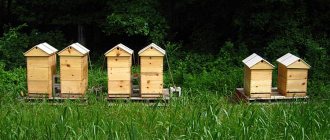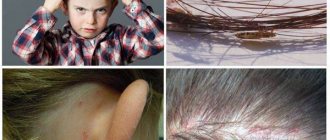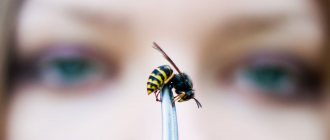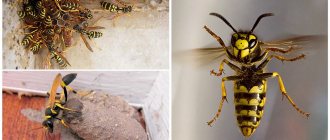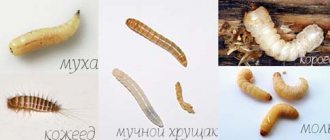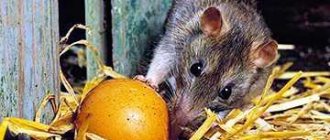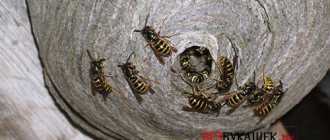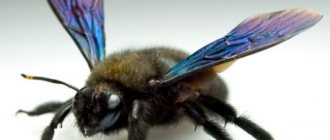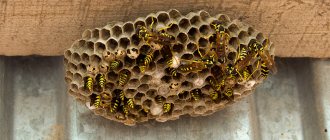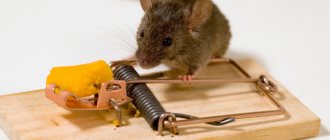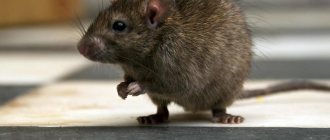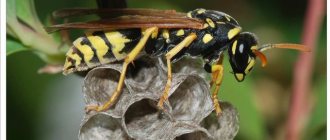The appearance of a wasp in an apartment evokes various emotions, from horror and panic to the practical interest of a novice entomologist. One individual flying in in search of food is not worth worrying about. You can catch it or wait until it flies away on its own. The problem occurs when the queen makes a nest in or near the apartment. A growing colony will become a threat to people; in some cases, it will be necessary to involve specialists in exterminating insects.
How insects get into an apartment
In summer and autumn, at any time you can find a striped guest in the apartment. She can get into the room in various ways:
- through an open window or vent;
- fly into an open door;
- crawl through the crack of the window frame;
- get through the ventilation duct from the attic;
- if the nest is located on the facade, its inhabitants gnaw passages in the wall.
If a wasp flies into the house in the spring, then it is a queen looking for a place for a nest. One insect easily hides from the eyes of residents and builds a house for its family somewhere in a secluded place.
Attention. Insects often settle in the drawers of the lifting mechanisms of roller blinds or blinds.
The queen feeds her larvae with flies and food scraps from the table. Until the first generation grows up in June, uninvited neighbors do not attract attention. Having noticed 6-7 adult individuals in the room, you need to find a nest. To do this, you should put bait from pieces of meat or minced meat and watch for insects. You can get rid of the entire colony at once using poisoned food. An insecticide is added to the meat bait and left in the open. Wasps chew food before feeding, they will poison themselves and poison all the larvae.
Attention. If there are animals in the house, it is necessary to place poisonous bait in places inaccessible to them.
There are several reasons why wasps fly into an apartment:
- They are attracted to the smell of food. Do not leave jam, compote, or honey in an open container. Fruits lying on the table or cores in the trash can are also liked by insects.
- One of the reasons is the search for a place for a nest. Females remember the place of their birth and instinctively look for a secluded corner not far from it.
Options for getting rid of the hive and its owners
Today there are many ways to help you get rid of a swarm of bees, wasps and a wasp hive. It is worth highlighting the point that bees do not bite people if they are not in danger.
You can kill insects that inhabit the hive using the following means:
Spray
This is one of the most toxic and widespread methods to kill bees. It can be purchased in specialized departments in supermarkets or in gardening stores.
Wasp spray contains insecticides that kill these insects
Before starting work, put on protective clothing and adhere to all necessary safety precautions specified in the instructions for use. The spray is quite easy to use. Spray the nest with it for ten or fifteen seconds. Then immediately move away from this place to avoid toxic substances entering the respiratory tract.
Smoke
This method is suitable for those who do not trust chemistry and want to get rid of insects that have occupied the hive or created a nest in a more natural way. But you need to keep in mind that this method is only suitable if the nest is suspended. It is strictly forbidden to use it near the house, as fire may spread to it.
First you need to light a fire right under the insects’ home and leave it for about two hours. The smoke will suffocate the wasps, thereby forcing them to leave the nest. After this, make sure that it is empty, and only then knock it down.
Vacuum cleaner
For this method, you will need a vacuum cleaner with a long hose, a grille or a sieve (necessarily small) so that it is difficult for the wasps to get out.
Another method of getting rid of wasps is to purchase a wide vacuum cleaner with a long hose so that you can reach the nest
In order to eliminate a nest in an apartment, pour a soap solution (about 4–6 centimeters) into the vacuum cleaner. This is necessary in order to destroy them as they enter the vacuum cleaner. Bring the suction pipe to the entrance to the insects' home and hold it until you have sucked in all the inhabitants. Once the nest is empty, turn off the vacuum cleaner and cover the hole in the pipe with something thick. Leave it in this state for several hours. Once the humming noise inside disappears, you can safely dispose of the garbage containing the dead wasps.
This method of getting rid of insects is best suited if the insects are located near the ventilation grille that opens into your apartment.
Physical means
Destruction of a wasp nest or a hive with bees can be done with minimal use of various drugs and solutions:
- Place a garbage bag over the home of these insects, wrap the entrance with tape and tear it away from the attachment point. The bag is then burned.
- It is necessary to carefully knock down the nest with a long stick so that it falls into a previously prepared bucket of boiling water.
- If bees have moved into a previously empty hive that was located on your site, it is recommended to fill all its entrances with polyurethane foam.
These grayish houses are tightly attached to the surface, so it can be difficult to remove them
Folk remedies
There is a category of people who prefer to get rid of such insects using traditional methods:
- Treating a wasp nest with kerosene. An enema is filled with this substance, then the insects’ home is doused with it (it is advisable to be as far away as possible). These steps must be repeated every day until the uninvited guests leave your territory.
- There is a method that was used in ancient times to get rid of the above insects. It is necessary to collect glue from fruit trees such as pear and apple trees. A red rope is smeared with this substance and then hung near the home of these insects.
To exterminate wasps, you can use any of the above control methods.
Why you should get rid of wasps
Some people are ready to put up with buzzing neighbors who only occasionally visit the house. A humane position is not always justified; if wasps fly into an apartment, they are a potential threat to the health of its owners.
What dangers do people face?
- The insect bite is very painful, especially children and allergy sufferers. An angry individual can bite several times, because it does not leave a sting in the wound. The affected area turns red, swelling of varying degrees appears. The wound must be treated with an antiseptic (iodine, hydrogen peroxide, calendula tincture).
- Wasps do not hesitate to feed from animal corpses and garbage dumps, and after visiting these places they run over the table and food in the kitchen. They are carriers of intestinal infections that pose a danger to human health.
- Having powerful jaws, insects gnaw holes in fruits lying on the table.
Advice. If wasps often fly into your room, install a mosquito net on the window. It will allow you to ventilate the room, preventing insects from entering it.
Prevention
To protect yourself from repeated “invasion” of wasps, you need to:
- in winter, carefully walk around the house and pay attention to cracks in the walls, floor, doorway, openings of unclosed valves, emergency exits and other locations convenient for placing a wasp nest: they need to be carefully sealed;
- destroy empty nests left for the winter;
- Empty trash cans and bins regularly and wash them with disinfectant: the smell of rotting food can attract wasps;
- fruit trees are a tasty morsel for wasps, so if there are any, you need to collect fruits in a timely manner and pick up those that have fallen to the ground;
- hang a fake nest: wasps rarely build nests near other colonies, as they are very territorial, an artificial, beautifully decorated nest can be bought at the store or you can make do with a brown paper bag.
If a wasp nest is found on your property, in a house or apartment, you need to get rid of the uninvited “neighbors” as soon as possible. If the scale of the disaster is small and the wasp’s nest is small, you can do it yourself, but in some cases it is still better to turn to professionals.
Ways to destroy a wasp nest
Having discovered the colony house, it is necessary to destroy it. The sooner you do this, the better. The number of inhabitants of the nest is constantly increasing. Depending on the location of the structure, different methods must be used. The general recommendation for any method is to act in the evening or at night, when the wasps are inhibited.
Mechanical
To prevent insects from flying out of the house when it is knocked down, it is necessary to plug the entrance with a piece of fabric. Another way is to pour foam into the hole.
Attention. Before you start destroying a nest, you need to be suitably equipped - cover your hands with gloves, cover your face and neck with a cape, and clothes should be made of thick material.
Boiling water will help remove the wasp house on the balcony. A bucket of hot water is placed under the nest, and then the leg that attaches the structure to the ceiling is cut off. It is better to knock down a nest with a shovel with a long handle. Insects will not be able to get out of the house and will drown in the water. The place where the nest was built should be treated with a wasp repellent liquid.
The most difficult thing to deal with are insects whose refuge is outside, and they make their way into the apartment through gnawed passages. It is recommended to insert an aerosol spray into the holes and treat them thoroughly with poison. You can leave pieces of fabric soaked in insecticide (Karbofos, Aktara). Plaster the passages and also add insecticide to the solution. If the nest on the facade cannot be reached, it is recommended to contact a company specializing in insect extermination.
Chemical
When starting to destroy a wasp nest, it is important to take care of the safety of your household. It is better for them to leave the apartment during insect poisoning measures. The control tactics are as follows: the wasp repellent Dichlorvos, Dr. is sprayed into a thick garbage bag. Klaus, MOSQUITALL. The bag is placed over the nest and left for several hours. During this time, the insects will die from exposure to the poison. The structure can be removed and thrown outside, and the room can be ventilated. In cases where the bag cannot be put on, poison from aerosols is sprayed onto the nest.
Preventing an attack on an apiary
To save the bee family and ensure high productivity for your apiary, you need to take care of the safety of your bees in advance.
- Correct location of bee houses. You can protect the hive from wasps with the correct location of the apiary. It is recommended that beekeepers place houses in areas where there are no ravines, embankments, or vacant lots with sand. The soil should be dense, preferably black soil, with a thick grass cover. Philanthus wasps are sandy and dig holes in soil that lends itself well to this. If an apiary is located nearby, this becomes an ideal place for them. A carefully thought out location of the apiary will allow you to avoid attacks from enemies in the future.
- Plowing the soil. In the fall, it is recommended to plow the ground to destroy the burrows of not only wasps, but also other potential enemies. Plowing the soil is one of the most important methods of combating wasp wolves. In early spring, young individuals crawl to the surface of the earth and continue to breed and hunt for bees and their honey. Loosening the soil before the larva completes its development guarantees a significant reduction in the number of enemies and makes it possible to destroy them in advance. It is necessary to rid the bees of their enemies even before they begin to attack.
- Wasp traps Traps made from plastic bottles will help get rid of wasps in the apiary and prevent serious losses. You need to make a lot of them, place them around the perimeter of the site. Hang on young trees, fences, or any convenient place. Cut off the neck, turn it down, secure it with tape, tape, and staples. Cut holes on both sides and thread the lace. Pour bait inside. Wasps love honey, jam, lemonade, juice, syrup, as well as meat, which they carry for the larvae. Several dozen pests are caught in one trap per day. Protection needs to be updated periodically.
- Limited access. Many beekeepers use a method of controlling wasps such as limited access. In cold weather, when the bees are not yet very active, and their enemies feel great, you need to narrow the opening of summer in the hive. Leave a cut that a bee can crawl through, but a wasp cannot. During active summer, it is necessary to widen the entrance so that insects can safely carry their prey. To prevent wasps from entering the hive, special tubes of small diameter are installed. They allow bees to move freely in any direction and prevent enemies from climbing in. This safe, convenient method will help protect an entire apiary.
Ways to catch insects in the house
What to do if a curious wasp flew into the room? The easiest way to get rid of an annoying neighbor is to beat the insect with a magazine rolled into a tube or a fly swatter. Then carefully (perhaps she is still alive) brush the body onto a piece of paper and throw it out the window. The method is simple, but inhumane. A living creature does not have to be killed; it can be caught and released into the street. There are so many ways to catch a wasp in an apartment.
- The insect itself wants to leave the apartment, so just open the windows and doors and the little guest will fly away to freedom. You shouldn’t push her towards the window, waving your arms. This will be perceived as a threat and the wasp will sting.
- After waiting for the wasp to sit on a table or other flat surface, cover it with a jar. Slide a piece of paper under the container, then turn it over. Now the uninvited guest is trapped, take her outside and open the jar.
- A safe way to get rid of one or more individuals is a homemade trap. To make it you will need a 1.5 liter plastic bottle. It is divided into three parts, the top one is cut off. Bait is placed in the bottle - jam, fermented compote, kvass, beer. The upper part of the container is turned upside down and inserted into the lower one. Wasps, attracted by the smell of sweet food, will crawl into the trap and will not be able to get out.
Attention. People who are allergic to wasp venom should not catch the stinging insect themselves. Get someone to do this for you. For a healthy person, an accidental bite will cause an unpleasant sensation, but for an allergy sufferer, severe swelling or anaphylactic shock.
Stinging insects have no place in the apartment; even one is dangerous. The wasp may hide in food and bite your neck or tongue. Swelling of these organs threatens any person with suffocation. Having noticed a striped guest, it is better to drive it away from the house; if that doesn’t work, just slam it down.
Calling professionals
For certain reasons, some people cannot cope with wasps and destroy their nests on their own. In this case, you can contact and call a specialized service that will destroy the interfering insects.
However, when contacting professionals, you need to know some features of their activities:
- The cost of calling specialists ranges from 1000-1500 rubles for exterminating wasps in urban areas and from 2500 rubles for exterminating them in suburban areas. Moreover, for virtually all companies, the price of the service depends on the distance of the dacha plot from the city.
- It is recommended to use only those companies that guarantee that the insects will not reappear. Most organizations have a warranty period of 1-2 years.
- In some localities it is not possible to call a specialized service. In this case, you can ask for help from the SES or the fire service, but it must be borne in mind that fighting wasps is not their direct responsibility, so the service is provided exclusively by prior arrangement and usually specialists do not arrive immediately.
Dangerous neighborhood
At a summer cottage or in a country house, the harvest of sweet berries and fruits is at risk. The peak of wasp activity occurs in the second half of summer, when the offspring have grown and require food.
Wasps like to live in dry, ventilated places
Ripe berries and fruits, especially grapes, attract wasps with their sweet juice. Insects can cause significant damage to crops. They cause no less damage to apiaries, attracted by the sweet smell of honey. They will not disdain leftover food from the table and garbage, simultaneously transferring germs and pathogenic bacteria from the trash heap.
Wasps can cause significant damage to fruit crops
Wasps are aggressive insects. Having settled next to people, they will protect themselves, their nest and family from potential threats. Bites for no apparent reason are not uncommon, and if you kill one individual or disturb a nest, you may be attacked by a swarm. The sting is painful because the wasp injects venom, causing pain and swelling that does not subside for several days. For those prone to allergies, this can end sadly, even leading to anaphylactic shock. Bites are especially dangerous for children. Wasps cause a lot of trouble and anxiety to farm and domestic animals. Even if the insects are not aggressive, it is impossible to predict at what point they will decide that you pose a threat and launch an attack.
A wasp sting leads to swelling and is dangerous due to allergic reactions.
Construction material
So, what do wasps make nests from? The starting material for construction is various wood elements obtained by wasps from old stumps, trees, fences, various wooden buildings, etc. That is why the color of the nest is always predominantly gray.
How is the “production” of paper from which wasps build their nests? Having found a suitable source material, the insect sits down, releases a drop of its own saliva onto its surface and, backing away, begins to scrape off the finest wood fibers. The wasp is helped in this by its powerful jaws. Having collected a sufficient amount of material, the insect flies to the site where the nest is being built, where this lump is once again processed by the jaws and abundantly moistened with sticky secretion.
When the building material reaches the required consistency, the wasp sits on the edge of one of the cells of the nest, presses a lump of chewed wood against it and, backing away, stretches it into a thin strip, after which it takes the edge with its jaws and rolls the material in a perpendicular direction. Thus, the thinnest paper wall of the next cell is obtained.
Folk remedies
Chemicals in concentrated form can harm not only insects, but also humans. Therefore, it is not recommended to use poison in small spaces, and even more so when it is not possible to leave the apartment/house for several days. Folk remedies come to the rescue, tested over the years by our ancestors, who knew a lot about fighting various kinds of pests.
Vinegar has a rather specific smell and insects do not like it very much; as a preventative measure, you can spray curtains, drapes and other textiles with it. Instead of vinegar, you can use a detergent diluted in water: it remains on the wings of insects, the inability to fly leads to inevitable death. You can also make a mint tincture - an old, proven ancient method of fighting insect pests.
If for some reason the above does not suit you, then the most radical and no less cheap way is to call a special service. We are armed with the necessary equipment, protective clothing and experience in this difficult task.
You need to know the enemy by sight! When should you get rid of it?
Wasps can be classified into three types:
- Paper.
They have an elongated body and long thin legs. They are called that because they make paper to build their nests: they moisten wood fibers with their own saliva. Their nests are located in fairly protected places - on the eaves, at the end of open pipes, etc. They attack only in case of danger. Their bites are painful but not fatal. - American hornets
: with thick black antennae and short legs. Their nests can be found in the ground, on an empty wall. They are dangerous because of their aggression. They can attack in a swarm and sting several times. - European hornets
are brown with orange speckles. They build nests on empty walls or in trees.
If wasps have settled in your dacha - under the roof slope, in the attic, balcony, in utility rooms - you simply need to get rid of them, because you are not sure how they will react to you or your loved ones, even if you are at a respectable distance from the nest . While defending their home, they can attack you in a swarm. You are at risk anytime and anywhere if you are in an area where there is a wasp nest.
First of all, you need to find out the reason for the appearance of wasps on your summer cottage: either they settled here in a nest, or they simply flew in in search of food. If grapes and raspberries do not grow near your dacha, if there are no fallen pears and apples nearby, and there are simply myriads of wasps, then, alas, you need to look for their nest and destroy the uninvited neighbors not one by one, but all together. This measure is especially relevant if:
- the nest is built in the center of a vegetable bed or flower bed, and the wasps do not have the opportunity to work in the garden or garden;
- if they constantly hover over the table, in the summer kitchen, on the playground;
- if the nest is located in a potato bed: in September, when you collect potatoes, you risk being severely bitten.
If the wasps have taken root in the far corner of the garden, then you don’t have to touch them - after all, they actively exterminate garden pests.
Features of life
Ground wasps begin building nests in the spring at the first warming. Some species settle in sandy soil, while others choose dense soil. Females choose a suitable place.
The wasp digs the ground for its burrow with its paws, which it uses to push the soil away like a shovel. Powerful jaws are involved in the work, and wings help break through dense layers. The insect continuously waves them, the air enters special bags on the chest. The muscles contract, and air is pushed from the sacs through special channels to the jaws. They begin to work with such frequency that a depression is formed with a slight touch to the ground.
Insects can settle in a hole abandoned by rodents, in voids under the soil, near roots and dried trees, in an old anthill.
In the underground dwelling, females build honeycombs in the same way as outside. Chewed wood fibers and saliva produce a mass that, when hardened, looks like paper. From it, the queen builds the first 5–10 cells and lays eggs in them. After 1–1.5 months, larvae appear. The female takes care of them, brings protein food to each cell, and she herself feeds on flower nectar. When the larvae turn into adult insects, they are involved in the construction of a nest for new family members, searching for food, guarding and protecting the home.
By the end of summer, the colony of social wasps reaches its maximum size and numbers several thousand worker wasps and heterosexual individuals ready to reproduce. Only fertilized young females overwinter; the remaining members of the colony die.
Solitary species of ground wasps live separately, building small nests or occupying soil voids for reproduction. The female catches a small insect: a spider, a caterpillar, a fly and paralyzes the victim with poison. It lays an egg on its body and hides its prey in a hole. It will be food for the emerging larva, since the wasp does not care for the offspring. She immediately leaves the dungeon and seals the entrance. Young wasps that have grown from larvae emerge independently in the spring.
